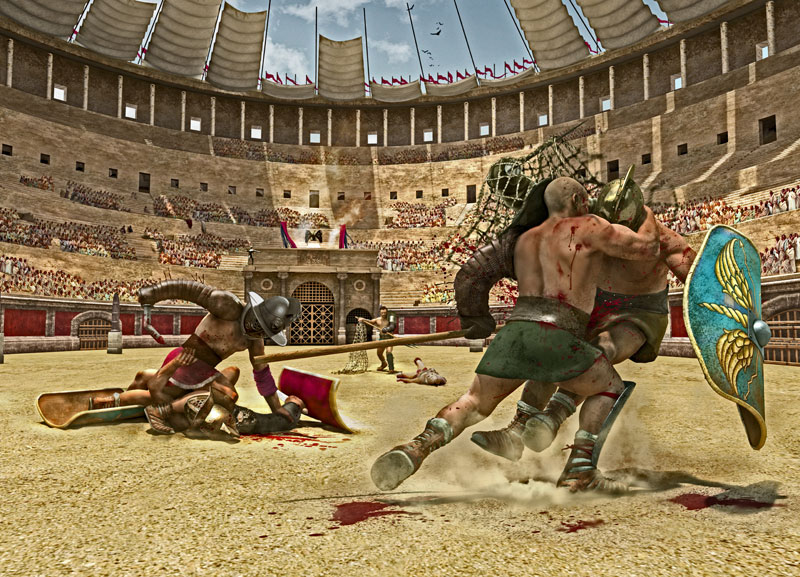Two men ready their weapons. An excited crowd of Romans cheer loudly in anticipation. Both combatants realize full well that this day might be their last.
They are gladiators, men who fight to the death for the enjoyment of others.
As the two gladiators circle each other, each knows that his objective is to maim or trap his opponent rather than to kill him quickly. What’s more, the fight must last long enough to please the crowd.
The gladiators jab swords and swing maces. They sweat in the hot sun. Sand and dirt fly. Suddenly, one gladiator traps the other with a net and poises to kill him with a three-pronged trident. The victor waits for a sign from the crowd. If the losing gladiator has put up a good fight, the crowd might choose to spare his life — and the vanquished gladiator will live to fight another day. But if the crowd is dissatisfied with the losing fighter — as was usually the case — its dissatisfaction meant slaughter.
In ancient Rome, death had become a form of entertainment.
The Etruscans of northern Italy originally held public games, (ludi), which featured such events as gladiator battles and chariot races, as a sacrifice to the gods.
The Romans continued the practice, holding games roughly 10 to 12 times in an average year. Paid for by the emperor, the games were used to keep the poor and unemployed entertained and occupied. The emperor hoped to distract the poor from their poverty in the hopes that they would not revolt.
Over time, the games became more spectacular and elaborate as emperors felt compelled to outdo the previous year’s competitions. The games involved more participants, occurred more frequently, and became more expensive and more outlandish.
The gladiators themselves were usually slaves, criminals, or prisoners of war. Occasionally, the gladiators were able to fight for their freedom. Criminals who were sentenced to death were sometimes thrown into the arena unarmed to serve their sentence. Some people, including women, actually volunteered to be gladiators.
They were willing to risk death for the possibility of fame and glory. Many gladiators went to special schools that trained them how to fight. A few gladiators boxed. They used metal gloves to increase cutting and bleeding.
Some gladiatorial contests included animals such as bears, rhinos, tigers, elephants, and giraffes. Most often, hungry animals fought other hungry animals. But sometimes hungry animals fought against gladiators in contests called venationes (“wild beast hunts”). On rare occasions, the animals were allowed to maul and eat a live human who was tied to a stake.
Gladiatorial bouts were originally part of funeral ceremonies. Most historians now argue that gladiator fights got their start as a blood rite staged at the funerals of wealthy nobles. When distinguished aristocrats died, their families would hold graveside bouts between slaves or condemned prisoners as a kind of macabre eulogy for the virtues the person had demonstrated in life. According to the Roman writers Tertullian and Festus, since the Romans believed that human blood helped purify the deceased person’s soul, these contests may have also acted as a crude substitute for human sacrifice.
How did Gladiatorial Games change from funeral rites to Games of Sport for Public Enjoyment?
The funeral games later increased in scope during the reign of Julius Caesar, who staged bouts between hundreds of gladiators in honor of his deceased father and daughter. The spectacles proved hugely popular, and by the end of the 1st century B.C., government officials began hosting state-funded games as a way of currying favor with the masses.


Comment (0)